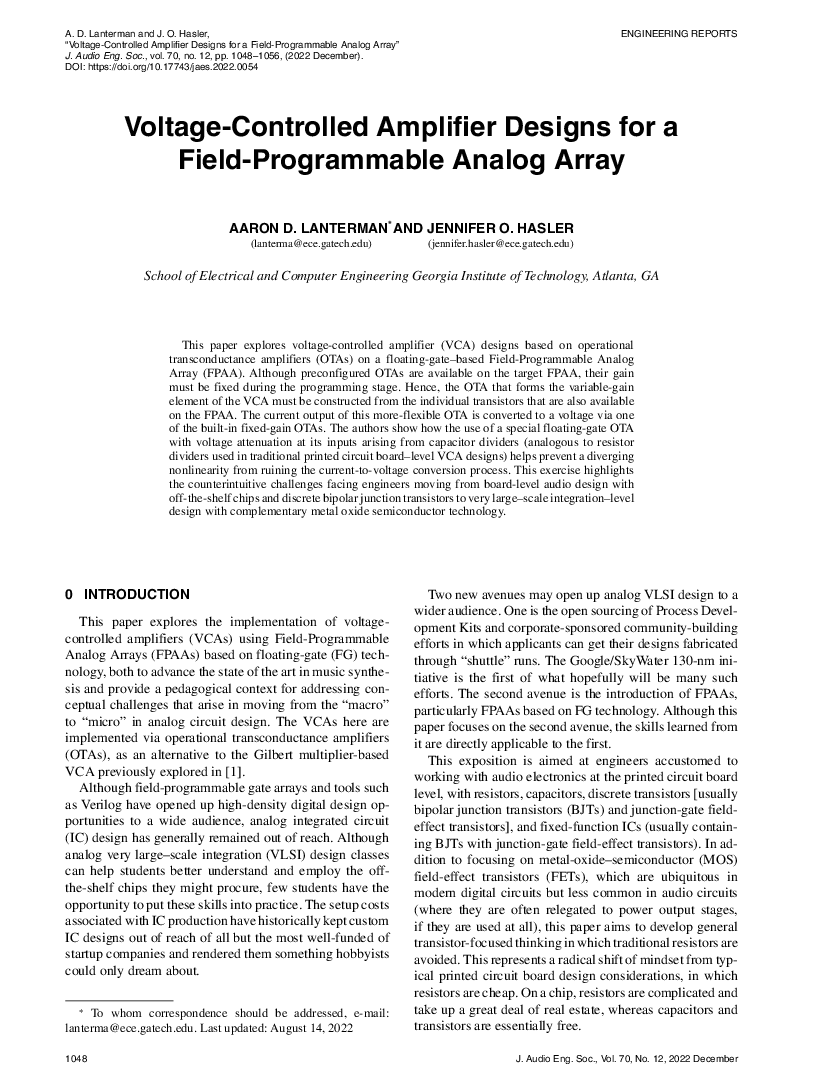Home / Publications / E-library page
You are currently logged in as an
Institutional Subscriber.
If you would like to logout,
please click on the button below.
Home / Publications / E-library page
Only AES members and Institutional Journal Subscribers can download
This paper explores voltage-controlled amplifier (VCA) designs based on operational transconductance amplifiers (OTAs) on a floating-gate--based Field-Programmable Analog Array (FPAA). Although preconfigured OTAs are available on the target FPAA, their gain must be fixed during the programming stage. Hence, the OTA that forms the variable-gain element the VCA must be constructed from the individual transistors that are also available on the FPAA. The current output of this more-flexible OTA is converted to a voltage via one of the built-in fixed-gain OTAs. The authors show how the use of a special floating-gate OTA with voltage attenuation at its inputs arising from capacitor dividers (analogous to resistor dividers used in traditional printed circuit board--level VCA designs) helps prevent a diverging nonlinearity from ruining the current-to-voltage conversion process. This exercise highlights the counterintuitive challenges facing engineers moving from board-level audio design with off-the-shelf chips and discrete bipolar junction transistors to very large--scale integration--level design with complementary metal oxide semiconductor technology.
Author (s): Lanterman, Aaron D.; Hasler, Jennifer O.
Affiliation:
School of Electrical and Computer Engineering Georgia Institute of Technology, Atlanta, GA
(See document for exact affiliation information.)
Publication Date:
2022-12-06
Import into BibTeX
Permalink: https://aes2.org/publications/elibrary-page/?id=22026
(479KB)
Click to purchase paper as a non-member or login as an AES member. If your company or school subscribes to the E-Library then switch to the institutional version. If you are not an AES member Join the AES. If you need to check your member status, login to the Member Portal.

Lanterman, Aaron D.; Hasler, Jennifer O.; 2022; Voltage-Controlled Amplifier Designs for a Field-Programmable Analog Array [PDF]; School of Electrical and Computer Engineering Georgia Institute of Technology, Atlanta, GA; Paper ; Available from: https://aes2.org/publications/elibrary-page/?id=22026
Lanterman, Aaron D.; Hasler, Jennifer O.; Voltage-Controlled Amplifier Designs for a Field-Programmable Analog Array [PDF]; School of Electrical and Computer Engineering Georgia Institute of Technology, Atlanta, GA; Paper ; 2022 Available: https://aes2.org/publications/elibrary-page/?id=22026
@article{lanterman2022voltage-controlled,
author={lanterman aaron d. and hasler jennifer o.},
journal={journal of the audio engineering society},
title={voltage-controlled amplifier designs for a field-programmable analog array},
year={2022},
volume={70},
issue={12},
pages={1048-1056},
month={december},}